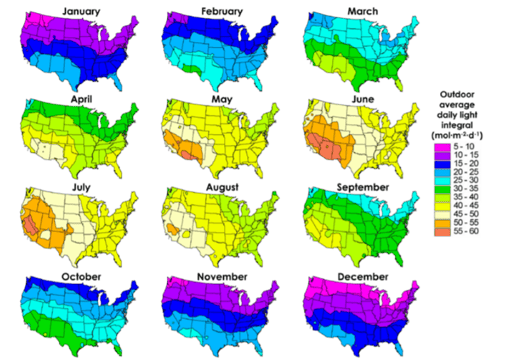There are many factors to consider when growing greenhouse tomatoes, and they will all play a part in the success of your operation. Your country, region, growing season, weather conditions, and facility materials will all have an impact on your tomato crop. They will also affect how you optimize your growing environment, including lighting, temperature, humidity, CO2, fertigation, and so much more. With all of these interdependent factors to consider, it’s best to reach out to advisers/specialists, such as plant and light experts, to help you optimize the growing conditions in your own greenhouse tomato operation.
Tomatoes are light-hungry plants, and light quantity, quality, duration, and distribution all play critical roles in the success of your tomato crop. When planning the supplemental lighting in your greenhouse, you need to first consider the natural light that reaches your plants. This can be influenced by your geographic region, the season, the time of day, the light transmission factor of the greenhouse glass, shaded spots within the structure, and more. While all these things may be beyond your control, you can control the light you provide to your plants.
Different plant species have different light requirements at each stage of development. The natural light shining into your facility plus the supplemental light you provide to plants on a 24-hour day make up the total daily light integral (DLI). The DLI is the sum of the photosynthetically active radiation (PAR) that plants receive over a day (but it should be noted that light outside of PAR, like far-red, also has an impact on plants).
Plants can be divided into high-light crops like tomato (~22-30 DLI) that need a high DLI in order to produce a high-quality product and low-light crops like Phalaenopsis (orchid) that require much less (~6-10 DLI). Providing your crops with optimal DLI is extremely important since it influences plant growth, development, yield, and quality. Fortunately, there is a technology that can help you to reach your DLI target over a given photoperiod, such as intelligent LEDs with predictive lighting controls like Heliospectra’s helioCORE™.
Sufficient DLI can drive the root and shoot growth of seedlings and cuttings, speed up production, and have an impact on characteristics like branching, flower number, and stem thickness. On the other hand, if your plants are receiving insufficient DLI, this can slow down and reduce growth and production levels. Since tomato is a high-light crop, insufficient DLI also affects fruit quality in terms of sugars and flavor. In low-light conditions, your plants may grow weak and have minimal fruit set and growth. If the DLI drops to very low levels, flower and fruitlet drops may occur.
Since DLI is dependent on both photoperiod and intensity, when light levels and day lengths drop in winter the DLI will decrease considerably, for example, in November through February in the United States (see map below). In such conditions, supplemental lighting needs to be at the right intensity and photoperiod to provide the DLI your plants need.

In addition to seasonal and daily changes to light, your greenhouse structure, glazing materials, cladding, internal obstructions, and more can limit the light your plants receive. If you are growing greenhouse tomatoes in the southwestern United States, for example, you might expect a DLI in mid-May of almost 60 moles/day outside but only 40 moles/day inside your facility. While tomatoes will be quite happy with 30+ moles, the challenge lies in keeping your DLI above 20+ moles at other times of the year with supplemental lighting, since that same operation in January may be receiving 20 moles/per day outside and 13 moles/day inside, increasing the DLI in the greenhouse most efficiently done with LED supplemental lighting. Even high light regions may benefit from increasing the DLI with supplemental lighting when natural light levels are low.
Our helioCARE™ team of experts can help with planning and supporting your ongoing growth goals. We can be your partner from the ground up, whether you need help with LED light planning, on-site support, and lighting trials to evaluate the best lighting strategy for your crop. By building a customized support plan, our team can help you achieve continuous quality and production improvements throughout the growing season. Let’s talk.
Be the first to know about LED lighting technology and the latest in horticulture. Get monthly updates with our most recent blogs delivered right to your inbox.